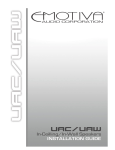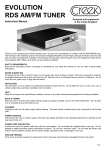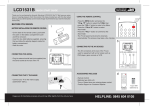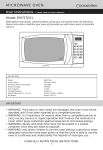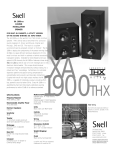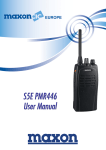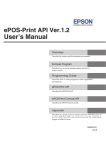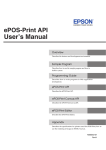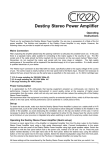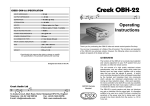Download EPOS MI MANUAL REVISED- July 20 08 to A1
Transcript
User Manual www.epos-acoustics.com This booklet contains information on the Epos Mi series loudspeaker range, with the exception of the M sub-woofer which has its own manual. POWER REQUIREMENTS Amplifiers with power outputs between those noted in the loudspeaker specifications will generally be adequate, although more powerful amplifiers could be used if care is taken to avoid over-driving the loudspeakers. Always use the volume control with discretion, and reduce the level immediately should the loudspeakers begin to distort. Amplifiers capable of less than 25 Watts per channel output are best avoided because they will restrict the dynamic range. Such amplifiers may also cause damage to the loudspeakers if they are driven beyond their capability in an attempt to obtain high volume levels. The clipping distortion produced when an amplifier is driven beyond its normal output capability can be very destructive. A powerful amplifier operating well inside its capability will generally be less likely to damage your loudspeakers than a lower powered amplifier operating beyond its capacity. NOTE: Do not make or break loudspeaker connections to the amplifier when it is turned on. POSITIONING Epos loudspeakers are designed to be positioned as specified. Space should be left behind the loudspeakers to allow proper operation of rear firing reflex ports and to ensure establishment of good stereo image depth. Some experimentation may be necessary to establish the ideal position within your listening room. Begin by placing the loudspeakers about 20cm from the rear wall and gradually move them out a little at a time until you achieve the best balance between bass weight and definition. Avoid placing the loudspeakers in corners because this may cause a doubling of low frequency output. Try to leave at least 40cm of space between each loudspeaker and the nearest side wall. The optimum stereo performance will be achieved when the speakers are positioned 2.5 metres or more from the listener and about the same distance from one another. Turning the speakers in very slightly towards the listener often helps to stabilize the stereo image. Speakers ‘image’ best if you can just see the top face of the speaker from your listening position. Remember, there is no absolute right or wrong - if it sounds good, it is good. QUICK CONNECTIONS Switch off your amplifier whenever making connections. Take your speaker cable and connect the positive terminal on the amplifier left channel, marked + or coloured red, to the positive terminal on the left loudspeaker. The negative terminal on the amplifier left channel, marked - or coloured black, must be connected to the negative terminal on the left loudspeaker. Repeat connections for the right channel. If you choose to bi-wire or tri-wire your loudspeakers, please read the detailed section on page 3. LISTENING Switch the amplifier on with the volume turned down low. Check that the bass and treble sounds come from both speakers. If not, switch off and remake the connections. RUNNING IN Your new loudspeaker system will require a total of approximately 24 hours of normal use to allow the components to settle into their working routine and reach their optimum performance. ALWAYS REMEMBER ? lower the volume before making any adjustments to the system (e.g. switching amplifier inputs or raising or lowering pickup arm). ? switch off the amplifier before checking or making any changes to any connections in the system. NEVER ? try to find out how loud the system will go. ? use your loudspeakers for any other purpose other than domestic listening. Page Two DISCLAIMER The 4mm plugs used on modern hi-fi speaker cables should never be inserted into European mains sockets even though they may fit. Needless to say, this is pointless and can be fatal if tried. Make sure that young members of the family are prevented from ever doing this. STANDS For loudspeakers designed for use on stands, best results will be obtained if the stands are rigidly coupled to the floor using carpet piercing spikes. Floor-standing loudspeakers should also be coupled to the floor using the carpet piercing spikes supplied. This will help preserve the outstanding mid-band clarity which is a hallmark of Epos loudspeakers. Epos has designed its own stands to suit the M5i and M12i. The floor-standing and centre channel models are supplied with their own support plinth. Contact your dealer for further information or visit the Epos website ww.epos-acoustics.com SPIKES Four threaded spikes are provided with each floor-standing speaker, together with individual locking nuts. These should be screwed into the metal inserts in the bottom of the cabinets, or into its plinth. Once these are adjusted to correct the level of the speaker and stop it from rocking, tighten the locking nuts, so as to prevent the spikes from coming loose. Adjusting the front spikes higher will tip the speaker up and can give sonic benefits. CONNECTION Ensure that your amplifier is switched off before you make, or break, any connections, because damage may occur to your amplifier if shorted. Your Epos loudspeakers are equipped with insulated nickel plated binding posts with excellent electrical contact and current specification. The posts are connected to the individual drivers as denoted on the rear panel label. Removable metal links enable the loudspeaker to be conventionally wired with a single cable, bi-wired or bi-amped, (tri-wired or tri-amped where applicable). These techniques often bring benefits in terms of increased clarity and definition. If you are in any doubt consult your dealer or visit www.epos-acoustics.com BI-WIRING/TRI-WIRING Bi-wiring involves the use of two pairs of speaker cables between your loudspeakers and amplifier. Tri-wiring requires three pairs of speaker cables. If you wish to bi-wire your M5i, M8i or M12i speakers, or tri-wire your M16i or M22i speakers it is essential that you first unscrew all the binding posts and remove the metal links that join them together. Store them safely for possible future use. Once the links are removed, the drive units will be electrically separate and should be connected to the driving amplifier with individual high quality cables, as shown. BI-WIRING SPEAKER AMPLIFIER To single wire, leave links in place SPEAKER AMPLIFIER To bi-wire, remove links TRI-WIRING SPEAKER AMPLIFIER To single wire, leave links in place SPEAKER AMPLIFIER To bi-wire, remove one pair of links, leaving the 2nd in place SPEAKER AMPLIFIER To tri-wire, remove both sets of links Page Three CABLE TERMINATION A set of 4mm plugs is supplied which will allow you to terminate your loudspeaker cables. These plugs have been selected to provide the best possible electrical connection. To terminate your cables simply remove enough insulation to allow the plastic shroud on the plug provided to fit over the end of your cable. Then make a connection to the plug and screw the shroud fully over the plug until no bare plug is evident. Once again, if you are in doubt consult your Epos dealer. Residents of the European Union may wish to use bare wires into the terminal posts, as 4mm plugs have been outlawed. L If bare wires are used, take care to avoid stray strands which can 'short circuit' the power amplifier. Spade type connectors may also be used. WARNING The sockets on the loudspeaker marked red (on the right side as you look at the loudspeaker rear panel) should be connected to the red (or positive) output terminals on your amplifier, while the sockets marked black should be connected to the black (or negative) output terminals on your amplifier. Use good quality cable to connect your loudspeakers to the amplifier. Ensure that the cables from each speaker are of roughly equal length and that any surplus is gathered in a loose hank. Do not coil the surplus tightly. PHASE If the cables are not connected to each left and right speaker in the same way, i.e. black and red reversed in one, the effect will be incorrect phasing. This will cause the bass to disappear and the stereo image to spread from the middle to a position outside the two speakers. Correctly wiring the polarity of the speakers will restore the image to between the speakers and provide proper bass. Most speaker cables have a polarising mark, such as a raised bump or writing on the positive wire. RUNNING IN Epos loudspeakers require a little gentle use to allow their working components to settle into their proper working routine. Do not be concerned if your new speakers sound aggressive and lacking in low-frequency authority when you first begin to use them. Things will quickly improve. Allow between twenty four and forty eight hours of use before you expect your new loudspeakers to perform to their full capacity. PROTECTIVE GRILLES Your Epos loudspeakers are supplied with protective grilles. The use of these is entirely optional and many owners prefer the appearance of the loudspeakers without them. A small reduction in clarity may be apparent with the grilles on. Do remember that young children and pets have an affinity for shining tweeter domes and woofer cones! If you wish to use the grilles, simply push them into the holes provided on the front panel, or pull them off to remove them. Page Four SPECIFICATIONS Power Handling Frequency Range Impedance Sensitivity Amplifier Compatibility Positioning Tweeter Bass/Midrange Driver Crossover Terminal Panel Internal wiring Cabinet Finish Size - HxWxD - mm / ins Packaged Weight Power Handling Frequency Range Impedance Sensitivity Amplifier Compatibility Positioning Tweeter Bass/Midrange Driver Crossover Terminal Panel Internal wiring Cabinet Finish Size - HxWxD - mm / ins Packaged Weight 100 Watts maximum amplifier power 60 Hz - 20 kHz 4 Ohm nominal 87dB/2.83V@1m 25 - 100 Watts Not less than 10 cm (4”) from rear wall Epos 25mm aluminium dome with high-temperature voice coil, ferrofluid cooling and ferrite magnet system. Magnetically shielded Epos mid bass 140mm, with 25mm high-temperature voice coil and injection-moulded PP cone mounted on an inert die-cast aluminium chassis. Solid metal phase plug. Magnetically shielded Bass driver crosses over with three components in a 2nd order filter. Tweeter has four components in a 3rd order filter at 3 kHz crossover, using film-caps and a metal oxide resistor. Bi-wirable. Can be single or double wired by removing shorting links provided. 0.8mm solid-core cable, Low-oxygen copper 18mm MDF wrap and 25mm MDF front baffle internally braced - with real wood finish Cherry, Red Cherry, Black Oak veneer 326 x 174 x 220 / 12.8 x 6.8 x 9 One pair per carton 6.7 kg / 14.8 lb per single speaker 16 kg / 35.3 lb per carton 150 Watts maximum amplifier power 54 Hz - 20 kHz 8 Ohm nominal 87dB/2.83V@1m 50 - 150 Watt into 8 Ohms Not less than 20 cm (8”) from rear wall Epos 25mm aluminium dome with high-temperature voice coil, ferrofluid cooling and ferrite magnet system. Magnetically shielded Epos mid bass 165mm with polymer cone,32mm high-temperature voice coil and diecast aluminium chassis. Magnetically shielded Mid Bass driver crossover is by mechanical design and without electrical network. Tweeter AC coupled with polypropylene capacitor and metal oxide resistor 6dB per octave at 5 kHz Bi-wirable. Can be single or double wired by removing shorting links provided 0.8mm solid-core cable. Low-oxygen copper 18mm MDF wrap and 25mm MDF front baffle, internally braced, with real wood finish Cherry, Red Cherry, Black Oak veneer 375 x 184 x 250 / 14.8 x 7.25 x 9.8 One pair per carton 8.4 kg / 18.6 lb per single speaker 20 kg / 44 lb per carton Page Five SPECIFICATIONS Power Handling Frequency Range Impedance Sensitivity Amplifier Compatibility Positioning Tweeter Bass/Midrange Driver Crossover Terminal Panel Internal wiring Cabinet Finish Size - HxWxD - mm / ins Packaged Weight Power Handling Frequency Range Impedance Sensitivity Amplifier Compatibility Positioning Tweeter Mid/Bass Driver Bass Driver Crossover Terminal Panel Internal wiring Cabinet Finish Size - HxWxD - mm / ins Packaged Weight Page Six 100 Watt maximum amplifier power 60 Hz - 20 kHz 8 Ohm nominal 87dB/2.83V@1m 25 - 100 Watts Either above or below the CRT or Plasma monitor. If close to the floor, angle the speaker up a little to aim at listener’s face Epos 25mm aluminium dome with high-temperature voice coil, ferrofluid cooling and ferrite magnet system. Magnetically shielded Epos 140m nominal, with 25mm high-temperature voice coil and injection-moulded PP cone mounted on an inert die-cast aluminium chassis. Injection-moulded phase plug. Magnetically shielded Bass driver crossover by four components in a 2nd order filter. Tweeter has four components in a 3rd order filter at 3 kHz crossover, using film-caps throughout and a metal oxide resistor. Bi-wirable 0.8mm solid-core cable. Low-oxygen copper 18mm MDF wrap and 25mm MDF front baffle internally braced, with real wood finish Cherry, Red Cherry, Black Oak veneer 180 x 510 x 220 / 7.1 x 20 x 8.7 (without grille or plinth) One centre channel and plinth per carton 10.8 kg / 22.8 lb per single speaker including plinth 13 kg / 28.7 lb per carton 200 Watts maximum amplifier power 48 Hz - 20 kHz 4 Ohm nominal 88dB/2.83V@1m 50 - 200 Watts Not less than 20 cm (8”) from rear wall Epos 25mm aluminium dome with high-temperature voice coil, ferrofluid cooling and ferrite magnet system. Magnetically shielded Epos Mid Bass 140mm with injection-moulded polymer cone and high-temperature voice coil, mounted on a die-cast chassis with phase plug. Magnetically shielded Epos Bass 140mm with injection-moulded polymer cone and high-temperature voice coil, mounted on a die-cast chassis with dust cap. Magnetically shielded Multi-element medium-order, at 150 Hz and 3 kHz. Tweeter has four components in a 3rd order filter at 3 kHz crossover, using film-caps throughout and a metal oxide resistor. Tri-wirable.Can be single, bi-wired or tri-wired, using shorting links provided. Mid-treble:0.8mm solid-core cabled. Bass: 1.2mm solid core. All low-oxygen copper 18mm MDF wrap and 25mm MDF front baffle, internally braced, with real wood finish Cherry, Red Cherry, Black Oak veneer 885 x 174 x 210 / 35.8 x 6.9 x 8.3 without grille - including plinth but without spikes One speaker and plinth per carton 16 kg / 35.3 lb per single speaker 21 kg / 46.3 lb per carton SPECIFICATIONS Power Handling Frequency Range Impedance Sensitivity Amplifier Compatibility Positioning Tweeter Mid/Bass Driver Bass Driver Crossover Terminal Panel Internal wiring Cabinet Finish Size - HxWxD - mm / ins Packaged Weight 300 Watts maximum amplifier power 38 Hz - 20 kHz 6 Ohm nominal 87dB/2.83V@1m 50 - 300 Watt into 6 Ohms Not less than 20 cm (8”) from rear wall Epos 25mm aluminium dome with high-temperature voice coil, ferrofluid cooling and ferrite magnet system. Magnetically shielded Epos Mid Bass 165mm with polymer cone,32mm high-temperature voice coil and injection moulded phase plug mounted on a die-cast chassis. Magnetically shielded Epos Bass 165mm with polymer cone, 32mm high-temperature voice coil and weighted injection moulded dust cap. Die-cast chassis. Magnetically shielded Mid bass driver crossover is by mechanical design and without electrical network. 6 dB on bass driver. Tweeter is AC coupled via polypropylene capacitor and metal oxide resistor, 6 dB per octave, at 5 kHz. Tri-wirable. Can be single, double, or tri-wired by using shorting links provided Mid-treble:0.8mm solid-core cable. Bass: 1.2mm solid core. All low-oxygen copper 18mm MDF wrap and 25mm MDF front baffle, internally braced, with real wood finish Cherry, Red Cherry, Black Oak veneer 900 x 184 x 250 / 35.4 x 7.25 x 9.8 without grille - including plinth but without spikes One speaker and plinth per carton 19.3 kg / 42.5 lb per single speaker 25 kg / 55 lb per carton WARRANTY WITHIN U.K. Your Epos Mi series loudspeakers have been built to very high standards and should give many years of trouble free service. If, within five years of purchase, they prove to be defective for any reason other than accident, misuse, neglect, unauthorized modification or fair wear and tear, we will repair the defect or, at our option, replace the faulty speakers without charge for parts, labour or return carriage. Your purchase receipt should be retained as it may be required in the event that you need to claim warranty attention. This warranty is applicable in the United Kingdom only and given in addition to your statutory rights. OUTSIDE U.K. Service enquiries in countries other than the United Kingdom should be addressed to the local Epos agent or distributor. Warranties granted in these countries are entirely at the discretion of the agent or distributor. Epos speaker systems are sold in more than 45 countries worldwide. Please see the Epos website for the complete list of international distributors together with all contact details. www.epos-acoustics.com Detailed information on all Epos products can be found by visiting the Epos website. www.epos-acoustics.com Epos Limited reserves the right to change the specification of any of its speakers without notice. Page Seven Designed and engineered in the U.K. REAL NATURAL WOOD This product has been finished with carefully selected real wood veneers. We scour the world to select the best and ensure that they are finished to the highest practical standards. As no two trees are alike, each pair of speakers is slightly different in colour, shading, grain and finish from all others. These pleasing variations are your guarantee of the unique and warm charm of your Epos speaker system. Each Epos cabinet is finished in a special lacquer, which ensures a maintenance free life. EPOS LIMITED 12 AVEBURY COURT MARK ROAD HEMEL HEMPSTEAD HERTS HP2 7TA ENGLAND Telephone: +44 1442 260146 Fax: +44 870 622 0846 E-mail: [email protected] www.epos-acoustics.com E&OE











